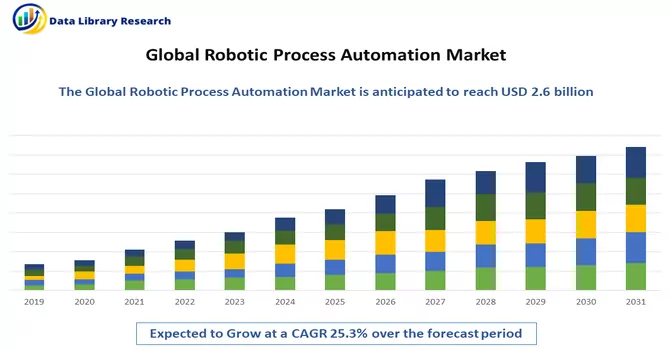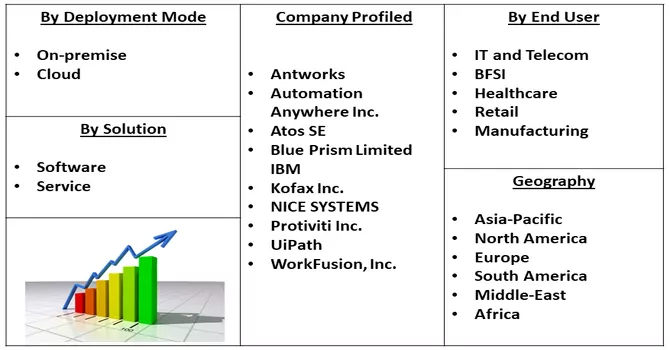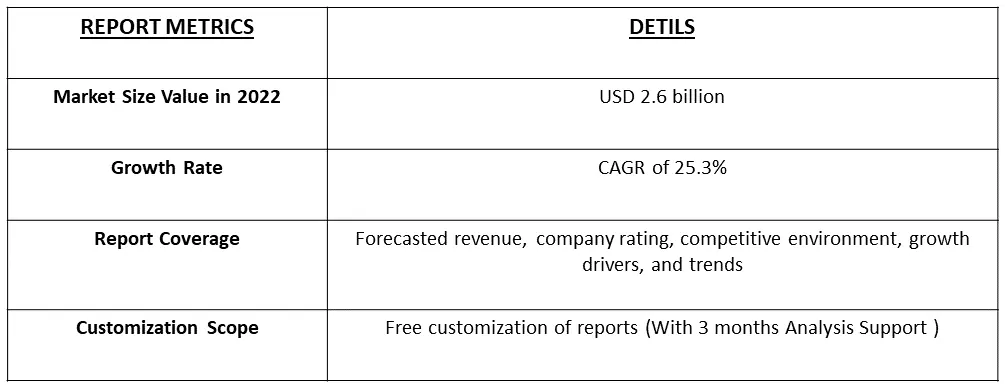Robotic Process Automation is currently valued at USD 2.6 billion in the year 2022, registering a CAGR of 25.3% over the forecast period 2022-2031.

Get Complete Analysis Of The Report - Download Free Sample PDF
RPA is an application technology that uses software with artificial intelligence and machine learning capabilities for handling high-volume, repeatable tasks. It allows employees to configure and program any computer software or robot to interpret existing organizational applications for manipulating data, processing transactions, and communicating with digital systems. The RPA is similar to traditional IT automation. Still, the significant difference between these technologies is that RPA can learn and adapt to changing circumstances, which a conventional IT automation system lacks.
The rising use of cutting-edge technologies like AI, machine learning, and the cloud will primarily fuel the robotic process automation market growth. More and more businesses are adopting RPA to automate business processes and handle increasingly complex data. Companies are developing and deploying cloud and AI-based RPA solutions to automatically optimize business processes and workflow. The increase in the adoption of Artificial Intelligence and cloud-based solutions for internal efficiency among SMEs is thriving the market growth.
Some of the major features of RPA for which businesses are adopting RPA include improved productivity, optimizing performance, integrating new technologies, generating higher returns, and moving business processes across the enterprise. All these factors mentioned have resulted in higher adoption of RPA across various industries, resulting in the growth of the robotic process automation market during the forecast period. Robotic process automation technology has been getting matured over the years. It is anticipated to become much more complex during the forecast period, as the latest technologies such as ML, OCR (Optical Character Recognition), and analytics are being integrated with RPA, enabling increased performance.
Segmentation:
The Global Robot Process Automation (RPA) Market Statistics, Forecast, and forecast are segmented
By Deployment Mode
By Solution
End User Industry
Geography
The market sizes and forecasts are provided in terms of value (USD billion) for all the above segments.

For Detailed Market Segmentation - Download Free Sample PDF
COVID-19 and the Russian War have negatively impacted the robotic process automation market and witnessed significant growth, owing to an increased usage of automated process automation solutions and increased social distancing norms, which will continue soon. Also, the human resource crunch observed by enterprises in industries is expected to further influence the adoption of RPA during the next two years, thus, driving the demand for such solution vendors. The industry continues to expand as software robots are used to manage regular tasks performed by temporary or seasonal workers and for staff peaks caused by regulatory spikes, new product launches, or new operations.
Drivers:
Growing Demand for Automation of Business Processes
The use of digital process automation is increasing as businesses are focused on digitizing their operations in order to become more customer-centric and responsive both in terms of how they meet evolving customer demands and introduce new products to the market. As its operating model becomes digitized and intelligent with the digital process automation industry, it also becomes possible to take more risks with product innovation.
Companies in the robotic process automation market have been collaborating to work towards offering enhanced RPA solutions in the market. For instance, in March 2021, Google partnered with Automation Anywhere to make the Automation Anywhere platform available in the Google Cloud, enabling both companies to develop AI mutually and RPA-powered solutions. Such collaboration has helped the availability of better RPA solutions in the market, enabling wider adoption in the market.
Optimization Of Operations to Gain Improved Productivity and Generate Maximum Return
Increased capability of RPA solution with the integration of AI technology in terms of improved business results, creating new positions, improved ROI, and reduced wage costs, among others. RPA robots can also perform activities across different systems to get information on digital platforms. For instance, adopting RPA in the finance industry helps bank customers check account details online and process KYC verification, along with other functions, through the Internet. Such services have resulted in reduced manual involvement and enabled the offering of improved customer experience.
Restraints:
The Reluctance of Employees to Switch from Manual to Automated Process
Due to the benefits offered by robotic automation, employees are reluctant and unwilling to switch to manual automated machines, thereby slowing down the growth of the studied market over the forecast period.
Segmental Analysis
Cloud Based Deployment segment is expected to Witness Significant growth Over the Forecast Period
Cloud deployment is the process of deploying an application through one or more hosting models—software as a service (SaaS), platform as a service (PaaS), and/or infrastructure as a service (IaaS)—that leverage the cloud. This includes architecting, planning, implementing, and operating workloads on the cloud. Thus, the benefits associated with cloud-based deployment systems are driving the growth of this segment.
Software Segment is Expected to Witness Significant growth over the forecast period
Robotic Process Automation (RPA) is software technology that's easy for anyone to use to automate digital tasks. With RPA, software users create software robots, or “bots”, that can learn, mimic, and then execute rules-based business processes. This software combined with AI can eradicate errors for efficient optimization of business processes and the creation of better strategies. Automation of repetitive tasks can lead to improved decision-making and result in more precise results. Thus, the segment is expected to witness significant growth over the forecast period.
IT and Telecom Segment is Expected to Witness Significant Growth Over the Forecast Period
RPA is essential to achieving both goals. RPA can automate basic tasks like updating customer records. Combined with AI processing, it can also help automate more advanced functions like network management. IT and Telecom companies are investing more and more in infrastructure and networks to keep up with increasing customer demands and evolving technology.
Telecom companies must maximize their returns on these technology investments by ensuring the technology works at optimal levels and driving down operational costs. RPA is essential to achieving both goals. Thus, the segment is expected to witness significant growth over the forecast period.
North America Holds the Highest Market Share in the Market Segment
Among the leading innovators and pioneers in adopting robotics, The United States is one of the largest markets. Robot use in the region continues to grow, helping make US companies more competitive and leading to new job growth. Further, according to the Robotic Industries Association (RIA), the most significant driver of the year-to-date growth of industrial robots was an 83% increase in units purchased by automotive OEMs for process automation. According to the Association for Advancing Automation, over 180,000 robots have been dispatched to various American companies since 2010, and more than 1.2 million new manufacturing jobs have been created during this time. According to MIT, automotive manufacturing accounted for a significant portion of the demand for industrial robots in the United States, followed by electronic, plastics, and chemical manufacturing. It is anticipated to augment robotic process automation (RPA) growth.

Get Complete Analysis Of The Report - Download Free Sample PDF
Competitive Analysis:
Robotic process automation (RPA) is highly competitive in nature due to the presence of many market players working in this market segment such as
These players have adopted various strategies to increase their market penetration and strengthen their position in the robotic process automation (RPA) in the financial services market forecast.
Recent Developments:
1) September 2022 - UiPath, a leading enterprise automation software company, strengthened its partnership with Snowflake, the Data Cloud company, by launching a new bi-directional integration that extends the value of automation across the enterprise. UiPath and Snowflake enable joint customers to design and build workflows based on 360-degree views of trusted and accessible data on Snowflake’s platform. By leveraging the Snowflake Data Cloud, UiPath robots can quickly connect data directly to business processes in the Data Cloud without using complex code, speeding up time to value.
2) August 2022 - Digital Workforce Services partnered with Keva, formerly Municipal Pension Insurance, to deliver a robotic process automation solution that was selected in a public procurement procedure. As part of the solution, the robotic process automation solutions in production were moved from the current environment used by Keva to Digital Workforce’s cloud service. The service includes solution maintenance, management, and support services. In addition, Digital Workforce offers professional services to Keva.
Q1. What is the Growth Rate of the Robotic Process Automation Market ?
Robotic Process Automation Market registering a CAGR of 25.3% over the forecast period 2022-2031.
Q2. Which Region is expected to hold the higest Market share Robotic Process Automation Market ?
North America holds the highest Market share in Robotic Process Automation Market
Q3. What segments are covered in the Robotic Process Automation Market Report?
Robotic Process Automation Market Report has covered segment like - By Deployment Mode, By Solution, End User and Geography.
Q4. Which technologies are used in Robotic Process Automation Market ?
The latest technologies such as ML, OCR (Optical Character Recognition), and analytics are being integrated with RPA, enabling increased performance.
Data Library Research are conducted by industry experts who offer insight on industry structure, market segmentations technology assessment and competitive landscape (CL), and penetration, as well as on emerging trends. Their analysis is based on primary interviews (~ 80%) and secondary research (~ 20%) as well as years of professional expertise in their respective industries. Adding to this, by analysing historical trends and current market positions, our analysts predict where the market will be headed for the next five years. Furthermore, the varying trends of segment & categories geographically presented are also studied and the estimated based on the primary & secondary research.
In this particular report from the supply side Data Library Research has conducted primary surveys (interviews) with the key level executives (VP, CEO’s, Marketing Director, Business Development Manager and SOFT) of the companies that active & prominent as well as the midsized organization
FIGURE 1: DLR RESEARH PROCESS

Extensive primary research was conducted to gain a deeper insight of the market and industry performance. The analysis is based on both primary and secondary research as well as years of professional expertise in the respective industries.
In addition to analysing current and historical trends, our analysts predict where the market is headed over the next five years.
It varies by segment for these categories geographically presented in the list of market tables. Speaking about this particular report we have conducted primary surveys (interviews) with the key level executives (VP, CEO’s, Marketing Director, Business Development Manager and many more) of the major players active in the market.
Secondary ResearchSecondary research was mainly used to collect and identify information useful for the extensive, technical, market-oriented, and Friend’s study of the Global Extra Neutral Alcohol. It was also used to obtain key information about major players, market classification and segmentation according to the industry trends, geographical markets, and developments related to the market and technology perspectives. For this study, analysts have gathered information from various credible sources, such as annual reports, sec filings, journals, white papers, SOFT presentations, and company web sites.
Market Size EstimationBoth, top-down and bottom-up approaches were used to estimate and validate the size of the Global market and to estimate the size of various other dependent submarkets in the overall Extra Neutral Alcohol. The key players in the market were identified through secondary research and their market contributions in the respective geographies were determined through primary and secondary research.
Forecast Model
